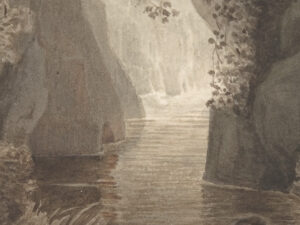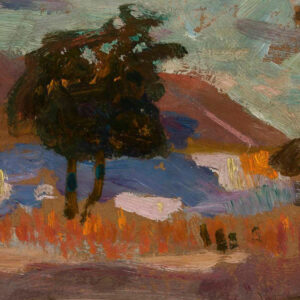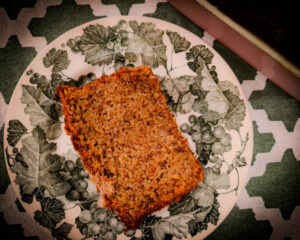Seven Suggestions for Growing
Bountiful Blueberries

(and Some Commentary on Robert Frost)
If you are fortunate enough to live in a place that hosts an abundance of wild blueberries, free for the picking, then skip this article — there’s nothing here you need. Your time will be better spent revisiting Robert Frost’s 1915 poem “Blueberries” and then making good on his advice. As he notes, “It’s a nice way to live / Just taking what Nature is willing to give / Not forcing her hand with harrow and plow.”
For you others, you who, by accident of birth or (questionable) choice of relocation, must walk through life in the more barren and berryless places — you who have no time to lallygag and read poetry but must instead labor to bring forth fruit from the stubborn earth, please press on. Here follow suggestions for some necessary hand-forcing.
1. Go low, high, or rabbiteye.
When first setting out, there are a few general categories of blueberry that you’ll want to consider. These include lowbush, highbush, and rabbiteye.
Lowbush varieties, as you will have surmised, are low bushes — generally reaching a foot or so in height, depending on the particular variety. They grow well in chilly places such as hardiness zones three to six. They often produce small berries, but do not be deceived: despite the diminutive size, these berries pack a stupendous punch — rich, deep, sweet, blueberry-y flavor. Lowbush also happen to work well for ornamental purposes, so if you’re fond of edible landscaping, it’s a win-win.
Our friends who abandoned this article for wild-picking and poetry are able to do so thanks to lowbush varieties — these are the original blueberries, the ones that grow wild, especially in New England and Eastern Canada. Even when intentionally planted, lowbush are sometimes synonymously called “wild blueberries.” They are the sort Frost was writing about, likely from his small farm in New Hampshire. Domesticated blueberries, incidentally, are a fairly recent thing; most blueberries were wild until just after the time of his poem. The first commercially grown crop went to market in 1916.
The domestication process ultimately resulted in the highbush varieties. You may not find highbush blueberries in the wild, but you can find them in the store — the grocers’ versions that you’re used to are typically highbush. Highbush are large, woody plants, which can easily reach eight feet in height at maturity. They tend to be prolific, tend to produce larger berries than lowbush, and tend to be easier to harvest because you don’t have to bend down so much. Highbush are reliable producers and fairly disease resistant, bearing tasty fruit, albeit potentially less sweet than lowbush. Highbush are the most popular varieties currently grown. They are sub-divided into northern highbush, which do well in zones three through eight or so, and southern highbush, which prefer warmer conditions, zones five through eight and sometimes even down to ten.
Also on offer, and worthy of strong consideration, are hybrid varieties, which are a cross between highbush and lowbush, bringing some of the benefits of both. These grow to roughly half the height of highbush. They are called, cleverly, half-high.
Finally, berry enthusiasts in southerly climes should also consider rabbiteye varieties (suited to zones seven to nine and then some). Rabbiteye may take a full decade to mature, but when they do you’ll have a lovely bush, or shall we say a tree: potentially twenty feet tall and ten feet wide, bearing magnificent fruit — justly counted among the true blue delights of Dixie. The name arose because the berries start out pink, like the color of a white rabbit’s eyes, before turning blue (and, presumably, because it was easier to say than “higherhighbush”).
2. Vary your varieties.
So far we have only discussed the high-level categories. Within each of them, there are countless varieties to choose from. Woodard, Tifblue, and Brightwell are among the many rabbiteye varieties worth exploring. Ruby Carpet is a popular lowbush, which makes a nice ground cover, and Polaris is a praiseworthy half-high option. If you’re looking at northern highbush, Blueray, Jersey, and Patriot are good choices. Folks in the southern highbush realms should consider Cape Fear, Gulf Coast, and Blue Ridge. But there are countless other wonderful varieties within each type to consider, far more than we can hit in this short discussion, and specific requirements will vary. So you will need to study details for your particular variety(ies).
And regarding the above optional pluralization: it’s not actually all that optional. Many blueberry plants require at least one other blueberry plant to be pollinated. Others are self-pollinating (especially many highbush varieties), but the size and yield of berries are increased when they are pollinated by another cultivar. So having multiple plants, ideally from multiple varieties —within the same type — is your best bet, even if you get self-pollinators. Our counterparts who are reading the poem instead of these instructions are encountering “Blueberries as big as the end of your thumb / Real sky-blue, and heavy, and ready to drum / In the cavernous pail of the first one to come”; proper selection and incorporation of multiple varieties provide your best shot at achieving the same.
3. Location is everything.
Blueberries are perennial shrubs, not garden vegetables, so your decision about location has long-term implications.
Be sure to plant in a spot with well-drained soil. Some varieties can be planted in raised beds, giving you more control if the soil on your land tends to be soggy. Some varieties, as noted above, grow very tall, so you need to consider buildings, nearby trees, et cetera, especially for highbush and rabbiteye varieties. You must place individual plants sufficiently far from impediments and one another to accommodate their full-grown size. Proper spacing also helps with airflow and helps prevent disease, such as powdery mildew. Additionally, good spacing gives blueberries’ root system plenty of space to spread out, and it keeps the plants from competing for sunlight. Speaking of which, blueberries should be planted in full sun; at least six to eight hours of direct sunlight every day is best.
Finally, despite the fact that location is everything, timing is also everything. And timing depends on your location. It is generally best to plant blueberries in the early spring. But in real life, spring planting can be tricky to time; so in warmer places (zones six and higher or so) autumn planting may be a good option, if done well before ground temperatures near 45 F° — this allows the plants to be established in time to benefit from spring rain instead of being forstalled by it. Regardless, be sure to do it late enough in spring or early enough in fall that you are certain to avoid frost (the other kind).
4. You ought to amend your soil.
The reason blueberries are not already growing wild outside your window may be in part due to the fact that the soil in your area is likely not suitable for them. Blueberries need fairly acidic soil. Optimal pH is generally around 4.5 to 5.0 (or a little high or low thereof; check the specifics for your varieties). So unless you know that your soil is already acidic, you’ll want to test and amend it before planting. There are many kits and products available for testing pH.
To acidify the soil, you can mix in elemental sulfur or peat moss. Normally you will mix in about two cups of sulfur per plant to decrease pH by one unit, though this varies based on soil type. For peat moss, make a two-inch layer on the top of the soil. Then work it into the top foot or so of soil. You can also put peat moss in the holes where you will plant the blueberries. Note: peat moss is effective and is a pleasant substance to work with, but there are some concerns about its sustainability and environmental effects. Use your judgment — perhaps you live in a peat bog and have a ready supply. (In that case, though, you probably also have a ready supply of wild blueberries and need not be reading this nor disturbing the peat moss.)
In any case, acidifying the soil is best done about a month before planting. It takes some time, for instance, for sulfur to be converted to sulfuric acid by bacteria in the ground, and the amount of time can vary — so test before you plant. Also, be sure to include lots of organic matter when you first plant.
Additionally, adding calcium when you plant can be good for helping establish strong roots, and incorporating calcium from time to time afterward can be good for cell-wall development and metabolism. But do not use limestone, as you may have done for certain other plants’ calcium needs, as it can raise the pH of your soil, which you’ve arduously worked to lower. Instead consider agricultural gypsum, which should not materially affect pH. This can also help deal with clay in the soil.
Acidic mulch can also be a good idea. Put a layer of pine needles, pine bark, rotted sawdust, or coffee grounds around your blueberry plants after planting, without mounding the mulch on the base of the plant. Try to maintain it about two to four inches deep. This will help in keeping the pH low as well as in retaining moisture for the blueberries’ roots.
None of this, though, addresses two curious lines in the poem you’re not reading, which advise: “It must be on charcoal they fatten their fruit / I taste in them sometimes the flavour of soot.” The obvious hidden message here is that you should consider incorporating biochar into your soil to aid root growth and density. This can provide various other benefits to your plants as well. You must be careful, as biochar tends to be alkaline: you might try amending with ten to twenty percent biochar several months before planting, giving time for some of the alkalinity to settle out — later do your other amendments and ensure pH levels are at target before proceeding.
5. Birds love berries.
We will assume that your feelings differ from those of Mr. Mortenson, who, in the poem, may “not care” about his blueberries and thus “leave the chewink to gather them for him.” Birds are all about berries, and accordingly, you must be all about scarecrows and fake owls and suchlike, to scare them away. Move these around regularly so the birds don’t get accustomed to them. You can also use metallic streamers or various shiny objects hanging on strings; when they blow in the wind, the flashing light startles and frightens birds.
If you have deer in your area, they can pose an even greater threat. Deer like blueberries as much as birds and humans do, and they can consume a lot of them in short order. If scarecrows and shiny things don’t do the trick, try odor repellents; if that doesn’t work, you may need tall fencing.
6. Less is more.
For the first two years after planting, instead of enjoying the few blueberries that might grow, remove the blossoms so that the plants can direct energy to growth rather than fruit production. It will be painful to sacrifice those first years, but good things come to those who wait. In the years that follow, the abundant crop will prove worth the sacrifice as you grow far more berries than you otherwise would have. You will also grow in patience and virtue.
In another minor act of purgation, after your highbush or rabbiteye blueberries have grown for four years, you’ll need to prune them each subsequent year. In the late winter, cut out dead, spindly, and crossing branches. Canes over six years old need to be removed as well. Every few years, it’s also good to give the berries a hard pruning, cutting about a third of the branches right to the ground, removing the oldest branches first. Pruning increases fruit yield and makes for overall healthier plants.
Lowbush varieties may merit a different approach. These can be mowed nearly ground level following harvest. Alternatively, they can be burned (as subtly endorsed by Frost: “the following fall / The fire ran and burned it all up but the wall”). They will fruit again, likely more abundantly, two years later. To accommodate an annual harvest, you can do this to half your crop in odd years, and half in even years — thus half is vegetative each harvest season, and half is fruiting.
7. Go ahead and read the poem.
Alright, you might as well check out the poem anyway. We seem to have already quoted half of it. Perhaps this whole article was really just an excuse for us to talk about our favorite blueberry poem. (And surely if we knew of any others, it would still be our favorite.)
So, despite what we said at the beginning regarding your not having time to lallygag, you should probably just dig out your Robert Frost anthology and lallygag with the real deal. And if you don’t have a Robert Frost anthology, that’s the first thing you ought to amend. He is one of the great American voices, brilliantly capturing the depth and loveliness of rural life. (And of blueberries.)
You might even consider making such a reading an annual ritual. This is a crop that requires some patience and dedication, and these require some inspiration — a yearly reading should do the trick. It will also be a nice way to kick off the picking season once you’re up and fruiting. To get you started, and to get it out of our system, we’ve taken the liberty of having an initial go at it on your behalf; click below to listen:




















